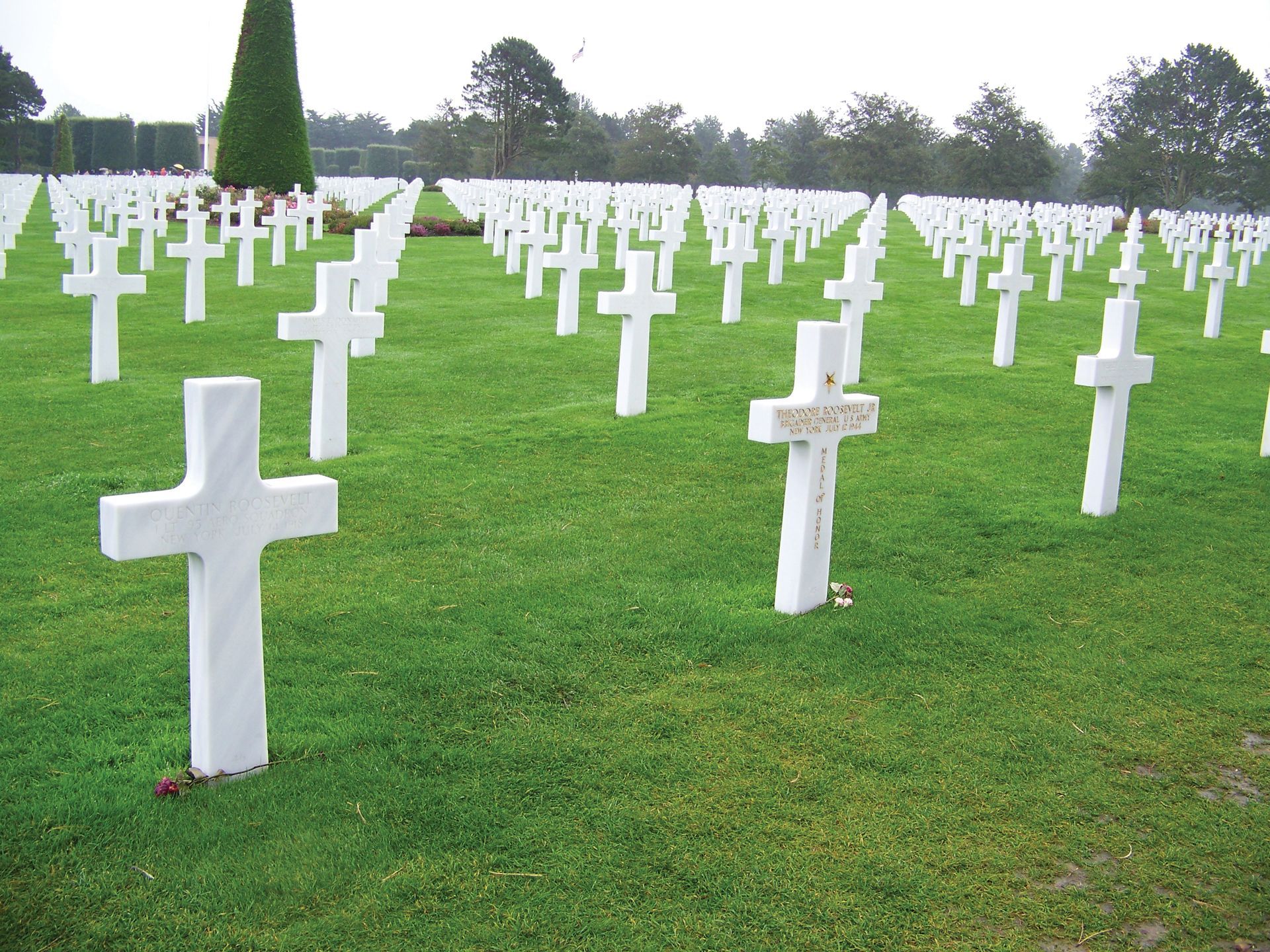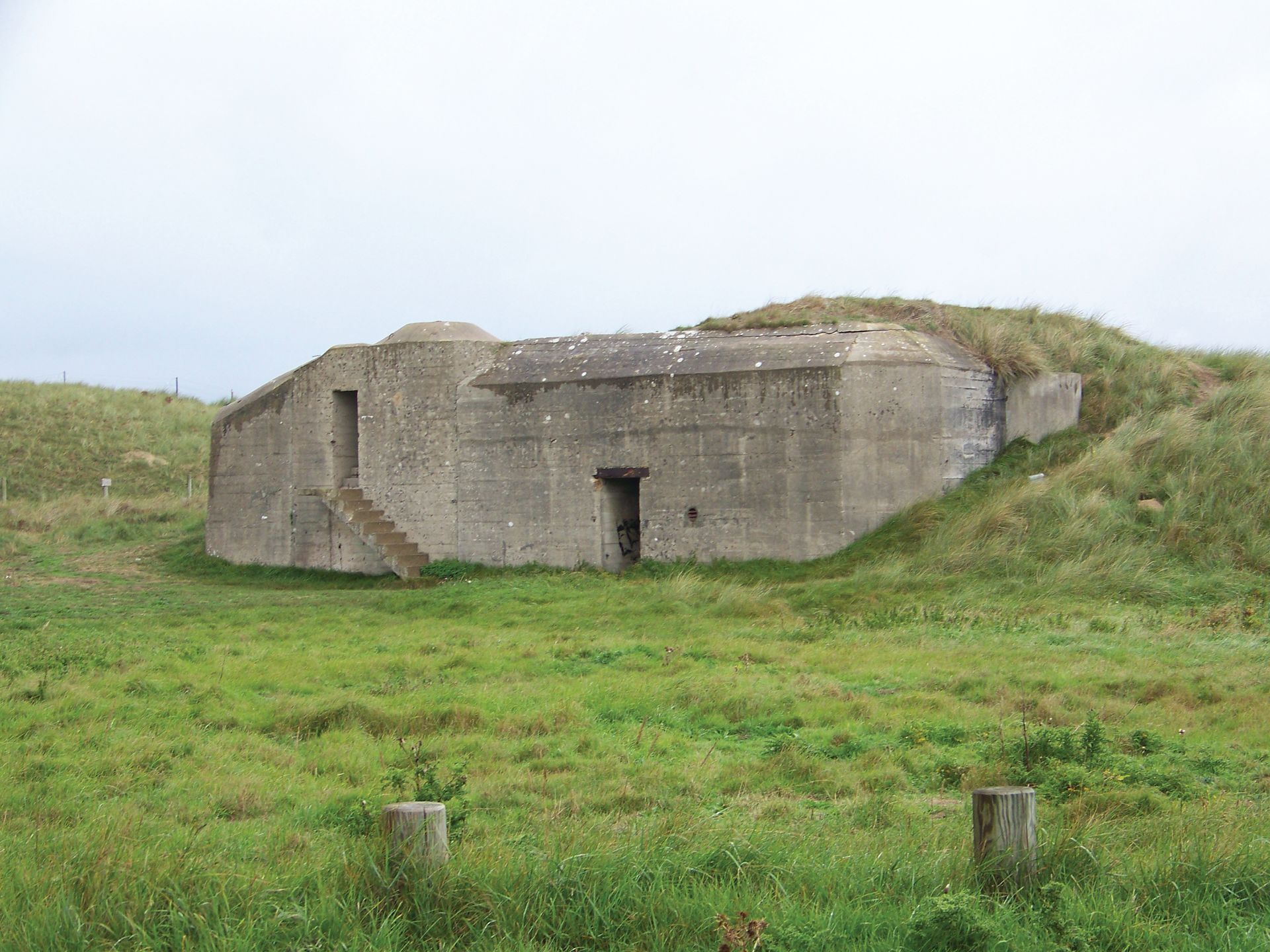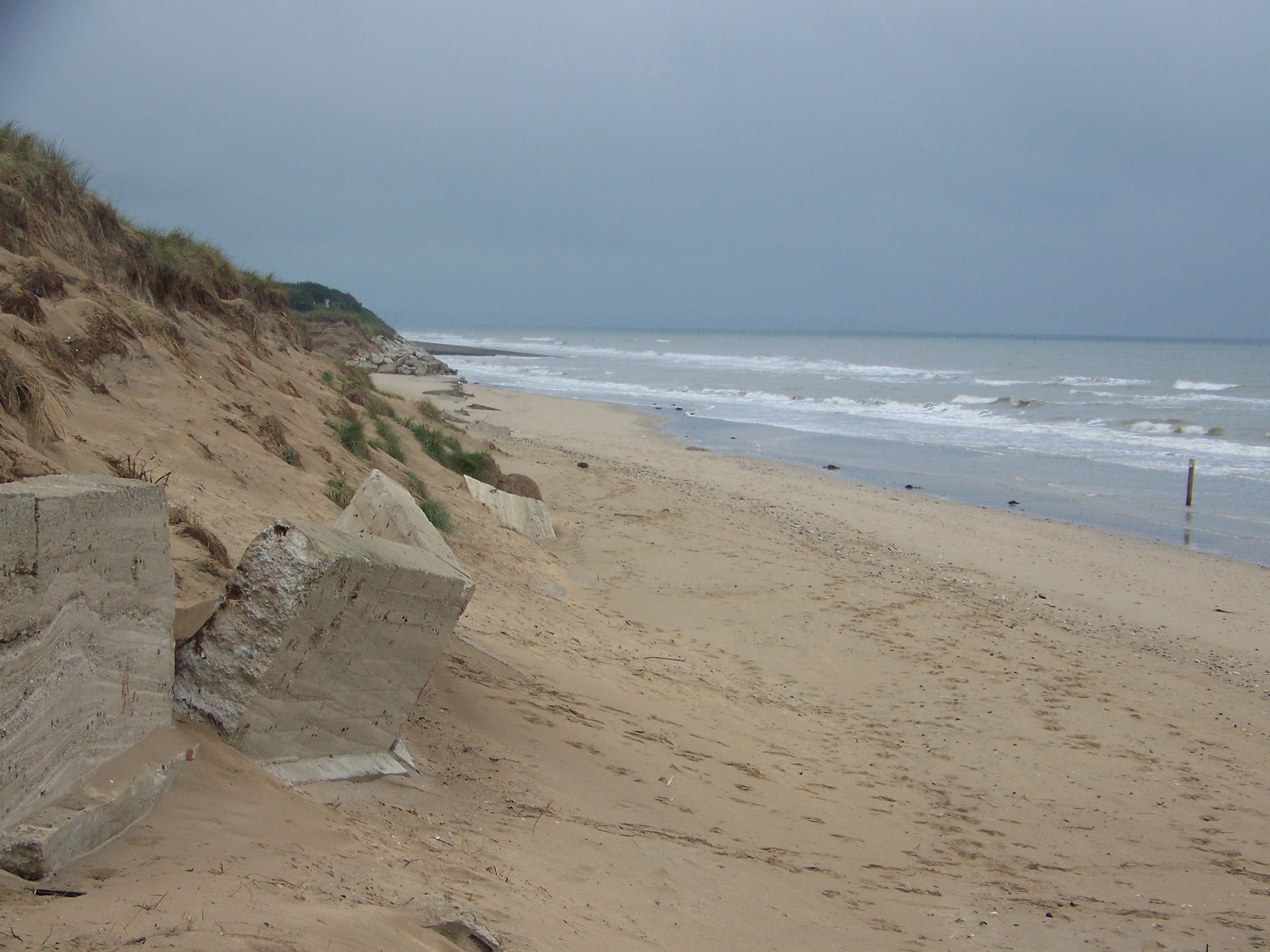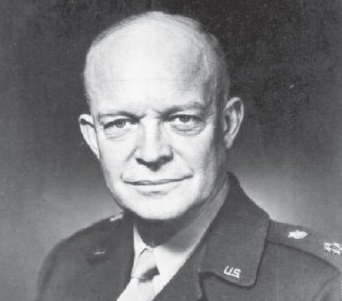
The American National Cemetery, Omaha Beach
(Author photo)
The Allied forces, consisting mainly of British, Canadian, and American troops, had trained for two years preparing for the liberation of Europe. Its people, from Scandinavia to the Pyrenees and Mediterranean Sea, and east to the Slavic countries, had spent four years under Nazi domination. Adolf Hitler, the Führer (leader) of the Nazis, anticipated an invasion and had prepared a massive Atlantic wall to prevent the Allies from entering his captured territory.
General Dwight D. Eisenhower, who served as the Supreme Allied Commander in Europe, knew that the time had come at last. “The American people, in their abhorrence of war, [had] denied themselves a reasonable military posture,” he explained. The eager recruits after Pearl Harbor were then incapable of dealing with the Nazi regime. By the spring of 1944 they were prepared. The armies, the navies, and the air forces of both the United States and Great Britain had worked tirelessly to prepare for their mission, which Eisenhower had named Operation Overlord.1
While not a regular church-goer, Eisenhower had been raised on the Bible, and was a believer in Providence. The name of the operation was named Overlord , because he realized that the Lord was needed to preside over this great battle.2

A German bunker, near Utah Beach
(Author photo)
General Eisenhower knew that, in order to succeed in reaching France and staying there, subterfuge against Hitler was essential. The deception plan was known as Operation Fortitude. Ike and British intelligence spent months perfecting this plan. Captured German spies were turned into British agents, and at least one double agent volunteered to aid the Allies in the deception. These agents fed the Nazis enough true intelligence to convince them of their veracity, then began giving false information as to where the invasion would take place. The Allies built fake encampments on the coast of England; they even built false tanks, jeeps, aircraft and landing craft from inflatable synthetic rubber. Nazi pilots flying on reconnaissance missions saw the pseudo-ordnance and reported it to their high command.
When General George Patton was reprimanded for slapping two soldiers, there was talk of a court-martial. Ike knew his fellow officer was too good a general to lose, and he realized that the Nazis would expect Patton to lead the invasion. “I made up my mind to hang on to him,” Ike remembered. “George could recover from emotion as quickly as he fell into it.” By keeping Patton in England until the advance had taken place, General Eisenhower knew the Nazis would be fooled in thinking that the invasion would not happen without Patton – Hitler and his ilk considered slapping two soldiers as an act of no consequence.3
Patton would come to France soon after the invasion with his Third Army – and he would be invaluable once the Allies had made an in-roads into occupied France.
The myriad troops – including the new Airborne units, which were army men trained to drop from planes into hostile territory – had carefully prepared. “I was raring to take out those Germans,” one airborne soldier remembered. With the deception working well against Hitler and his henchmen, the Allies needed to wait for favorable weather for the invasion.4
The weather on the Normandy coast is never fair for long. The English Channel, a narrow arm of sea between Great Britain and France, is often stormy. The attack had to come during favorable tides as well – narrowing the window of opportunity. General Eisenhower had planned for Operation Overlord to take place on Monday, June 5, 1944. A terrible storm caused him to delay for one day. As the storm passed more quickly than anticipated, Ike’s weather forecaster, J.M. Stagg, gave Ike and his generals the good news: that there would be a small time of fair weather, just when they needed to go. “It’s the best possible gamble,” said General Walter Smith, Ike’s Chief of Staff. British commander Montgomery agreed, declaring: “ I would say – Go !” Ike paced and thoughtfully contemplated before deciding. He refused to needlessly waste human life, and he knew the invasion was going to be costly in that precious commodity. More delay, however, would only aid the Nazis in strengthening the Atlantic wall. “Okay,” he said. “Let’s go.”5

Utah Beach
(Author photo)
The Nazis had believed the lies of Fortitude. Hitler, who considered his intelligence superior to everyone else, was certain that the invasion would come farther north at the Pas de Calais – where the narrowest part of the English Channel divided England from France. He also refused to allow his generals to act on their own recognizance. His Panzer divisions – an elite task force of tanks and men – were only allowed to be called into action with his permission. When the D-Day attack occurred, Hitler was asleep at his hilltop headquarters in Berchtesgaden. No one dared to wake him.7
Because the Nazis were convinced the storm would keep the Allies away that day, a war games conference was called at headquarters. There was no one from the German high command in Normandy as a result.
When the airborne troops prepared to leave for the fight, Ike visited them. His concern was evident. One of the men spoke up. “Now quit worrying, General! We’ll take care of this thing for you.” The General watched them take off, and waited until they were out of sight.8
The plan for Overlord was complex, but the Allies had spent months training their troops. Five beaches were targeted with the code names Utah, Omaha, Gold, Juno, and Sword. Villages and towns that were inland, as well as roads and bridges, had soldiers and airborne troops assigned for invasion, clearing, or destruction. It was important to continue inland, to block roads and destroy certain bridges to keep Hitler’s men out – but others were needed to allow Allies into France to stay. There was no retreat option.
Thousands of ships carried the Allied troops across the Channel. Multiple destroyers, armed with artillery, blasted the German concrete bunkers. The Airborne units, who had parachuted behind enemy lines hours before, crept up to the hidden German cannon – many of them camouflaged and unseen from the air – and took many of them out.
“The Krauts were dug into a long, winding trench system along a line of trees,” recalled William Guarnere of the 101st Airborne. “ The whole thing was well hidden. Could have been one gun, five, or fifteen in there.” By removing the artillery defenses, the chance for the infantry on the beaches was better secured. It worked for Utah, Gold and Sword beaches. However, on Omaha and Juno, most of the pillboxes and their big guns remained – airmen targeting those areas had either been killed, wounded, or had been dropped far from their areas. The highest casualties resulted from those latter beaches. Ike wrote, “The resistance encountered at Omaha Beach was at…the level we had feared all along the line.”9
Among those who took the heaviest casualties was the 116th Regiment, 29th Infantry Division. Most of these fighters were descendants of Union and Confederate veterans of the Civil War, and their knack for fighting was an inherited trait. They were considered the finest assault unit, and were specifically chosen by General Eisenhower to fight on Omaha Beach, where Ike knew the stiffest resistance would greet the troops.
While Utah, Gold, Juno and Sword beaches gently sloped onto the mainland, high bluffs dominated Omaha Beach. Ignoring that beach as a landing option was not possible. It would leave too great a gap for the troops pushing inland, allowing an infiltration between them from enemy combatants.

Omaha Beach
It is impossible to describe the chaos on Omaha Beach – the hardest one to take of the five beaches. Many drowned before reaching land. Others were wounded and drowned as the tide came in and took them out to sea. Some ships were blown when they hit mines, or received a direct hit from the German cannon. Other soldiers were destroyed by artillery and machine gun fire strafing them as they came ashore. The Nazis even shot at the medics as they worked to aid the wounded – a clear violation of the conduct of war.10
One of the division commanders shouted, “Two kinds of people are staying on this beach – the dead and those who are going to die.” He urged the men to keep going, and they strove onward.11
The soldiers surged ahead with determination. “You get the strength of an ox on the battlefield,” William Guarnere recalled. “ Your adrenaline’s going…your movements are quick, your body is in survival mode.”12
Many, though, did not survive. The 116th Regiment took the heaviest casualties of any unit at D-Day, while other units also took casualties. Many more survived, however, largely because it was a time of great unity between the Allied infantry and their naval and airborne counterparts. They worked in harmony, took over the beaches, and moved inland. The fighting in Normandy continued for many weeks, and more Americans and British soldiers were wounded and killed in the interim. The majority were barely out of high school.13
“In the first three weeks ,” Ike wrote, “our casualties totaled 60, 771 of whom 8975 were killed. By July 2, 1944 we had landed in Normandy about 1,000,000 men.”14
On D-Day in America, stores closed and church doors opened. The nation had learned of the invasion on the radio. President Franklin Roosevelt encouraged prayer and added one of his own. All over Europe, civilians listened to the news of Overlord. In her hiding place in Amsterdam, Anne Frank wrote in her diary, “This is D-Day…The invasion has begun !” Thrilled that she and her family might be able to emerge from hiding at last, she added, “I have the feeling that friends are approaching. We have been oppressed by those terrible Germans for so long, they have had their knives so at our throats, that the thought of friends and delivery fills us with confidence.”15
D-Day was the high tide of the Nazi regime. The war continued for eleven more months, which saw the death of Hitler and the end of the world’s deadliest war. An estimated 50 to 70 million deaths resulted from World War II – most being civilians who perished in concentration camps or died from the multiple bomb attacks in both western Europe and Great Britain.16
While young Anne Frank did not live to see her long cherished freedom, millions of others did. One of her last entries is particularly touching: “It’s really a wonder that I haven’t dropped all my ideals, because they seem so absurd and impossible to carry out. Yet I keep them, because in spite of everything I still believe that people are good at heart.”17
She is right. Eighty years ago, thousands stormed the beaches of Normandy with the specific intent to free the captives. Many gave up their lives to do so.
In an interview with news anchor Walter Cronkite, overlooking Omaha Beach on the 20th anniversary of D-Day, former President Dwight D. Eisenhower said, “They did it so the world could be free. It just shows what free men will do rather than be slaves.”18
The D-Day Memorial on Utah Beach has inscribed: “The Fallen will Never be Forgotten, the Veteran will ever be Honored…The Greatest Amphibious Invasion in History, their Selfless Cause was to Destroy Tyranny and Restore Freedom.”19
D-Day was the Gettysburg of World War II: both battles incurred the highest casualties of their respective wars, and both marked the beginning of the end of those wars.
Most of the combatants on the beaches of Normandy are gone now. We remain grateful for what they did. They accomplished what was considered impossible, eighty years ago.

General Eisenhower commanded Operation Overload
(Library of Congress)
Sources: Ambrose, Steven E. D-Day: June 6, 1944, The Climactic Battle of World War II. New York: Simon & Schuster, 1994. Eisenhower, Dwight D. At Ease: Stories I Tell to Friends. National Park Service: Eastern Acorn Press, 1967. Eisenhower, Dwight D. Crusade in Europe. New York: Doubleday & Company, Inc., 1948. Frank, Anne. The Diary of a Young Girl. New York: Doubleday & Company, Bantam Edition, 1967. Guarnere, William “Wild Bill” and Edward “Babe” Heffron. Brothers in Battle, Best of Friends. New York: Berkley Caliber, 2007. Holl, Jack M. The Religious Journey of Dwight D. Eisenhower. Grand Rapids, MI: Wm. B Eerdmans Publishing Co., 2021. Ryan, Cornelius. June 6, 1944, The Longest Day. New York: Simon & Schuster, 1959. McManus, John C. The Americans at D-Day. New York: Tom Doherty Associates, 2004. Smith, Jean Edward. Eisenhower in War and Peace. New York: Random House, 2013. Additional information from the D-Day Memorial, Utah Beach, Normandy, France, and the Eisenhower National Historic Site, Gettysburg.
End Notes:
1. Eisenhower, Crusade, p. 7. Many British troops and some Americans had fought in Europe before D-Day. The English had fought at Dunkirk, Norway, and North Africa, to name a few. Some American troops had also fought in Africa and in Italy.
2. Holl, p. 138.
3. Eisenhower, At Ease, p. 270.
4. Guarnere & Heffron, p. 65.
5. Ambrose, pp. 187-188. Holl, p. 116. McManus, p. 117.
6. Ryan, p. 145.
7. Ambrose, p. 191.
8. McManus, pp. 129-130. Eisenhower, Crusade, p. 252.
9. Guarnere & Heffron, p. 65. Eisenhower, Crusade, p. 253.
10. Ryan, p. 204. Ambrose, pp. 391-392.
11. Smith, p. 358.
12. Guarnere & Heffron, p. 67.
13. McManus, p. 288.
14. Eisenhower, Crusade, p. 270.
15. Frank, pp. 244-245.
16. The numbers vary greatly as to how many perished in the war. Some German cities, like Frankfurt, Berlin and Dresden, were so heavily bombed that a significant portion of the populations of those cities were killed. It is impossible to know how many who died as a result.
17. Frank, p. 263.
18. Ambrose, p. 583. The film of the interview is visible at the Eisenhower National Historic Site, Gettysburg.
19. The D-Day Memorial, Utah Beach, Normandy, France.
On June 6-9, there will be a D-Day event at the Eisenhower National Historic Site, with encampments, exhibits, living historians and guest speakers, which is offered free to the public, at 250 Eisenhower Road. Visit nps.gov for schedule and details.

